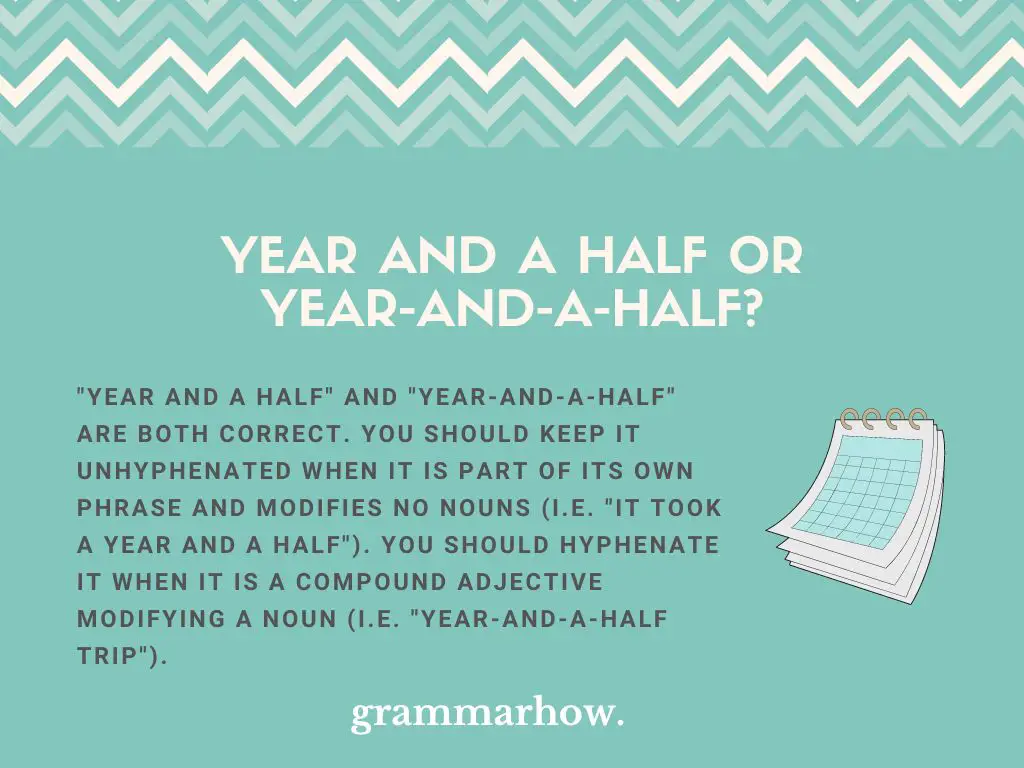“Year and a half” is commonly used to refer to something’s age. You can pluralize it with phrases like “two years and a half,” but the rules stay the same when it comes to hyphenating it. This article will explain whether to keep the words separate or hyphenate them.
Year and a Half or Year-and-a-Half?
“Year and a half” and “year-and-a-half” are both correct. You should keep it unhyphenated when it is part of its own phrase and modifies no nouns (i.e. “it took a year and a half”). You should hyphenate it when it is a compound adjective modifying a noun (i.e. “year-and-a-half trip”).

AP Style rules teach us everything we need to know about hyphens. According to the AP Stylebook, you should hyphenate multiple words when they modify the same noun in a sentence. This applies when the noun comes directly after it:
- A year-and-a-half trip.
Here, “trip” is modified by “year and a half.” You should keep the words hyphenated to show they all share a common modification link.
You do not have to hyphenate the words when using them as a standard phrase. If they don’t modify another noun, “year and a half” works like this:
- He is one year and a half.
Year and a Half
“Year and a half” is correct as a phrasal noun. It is very commonly seen like this when talking about the age of something.
Hyphens show modification, but “year and a half” does not modify anything when used as a phrase. Instead, it refers to something’s age or how long it took to complete something.
- All of that happened a year and a half ago. You can’t still be upset about the incident.
- He is a year and a half. We’re so proud of our little boy. We love him more than anything.
As you can see, “year and a half” works well to establish an age. You do not need hyphens because no nouns come directly after the phrase.
These rules apply whether you use the singular “one year and a half” or plural forms (i.e. “two years and a half” or more):
- You are two years and a half now! You’re halfway to your third birthday already!
Year-and-a-Half
“Year-and-a-half” should be hyphenated when it comes directly before a noun it’s modifying. This is how the AP Stylebook uses hyphens, showing that multiple words can modify the same noun.
Hyphens are linkers, according to the AP Stylebook. They link common words to show the reader which parts modify the noun.
Without hyphens, you might find this sentence:
- A year and a half trip.
Here, “half” is the only word modifying “trip.” This means someone only went halfway across the distance they originally planned for their trip. This is not the intention of the sentence.
That’s why you should hyphenate all the words:
- A year-and-a-half trip.
With hyphens, we can establish the full length of the trip by showing that all four words modify it.
- We took a year-and-a-half excursion to see what we could learn from the world. It was eye-opening.
- I’m not sure if the year-and-a-half baby will be able to make this trip.
Again, the plural forms still use hyphens when they modify the same noun:
- She has a two-years-and-a-half baby boy, and he’s the cutest thing I’ve ever seen!
Conclusion
You do not have to hyphenate “year and a half” when used as a standard phrase. As long as no nouns are modified by “year and a half,” it’s best to leave it unhyphenated.
You should only hyphenate the phrase when turning it into a compound adjective modifying the same noun. You’ll often find the noun comes straight after the adjective (i.e. “year-and-a-half child”).

Martin holds a Master’s degree in Finance and International Business. He has six years of experience in professional communication with clients, executives, and colleagues. Furthermore, he has teaching experience from Aarhus University. Martin has been featured as an expert in communication and teaching on Forbes and Shopify. Read more about Martin here.
